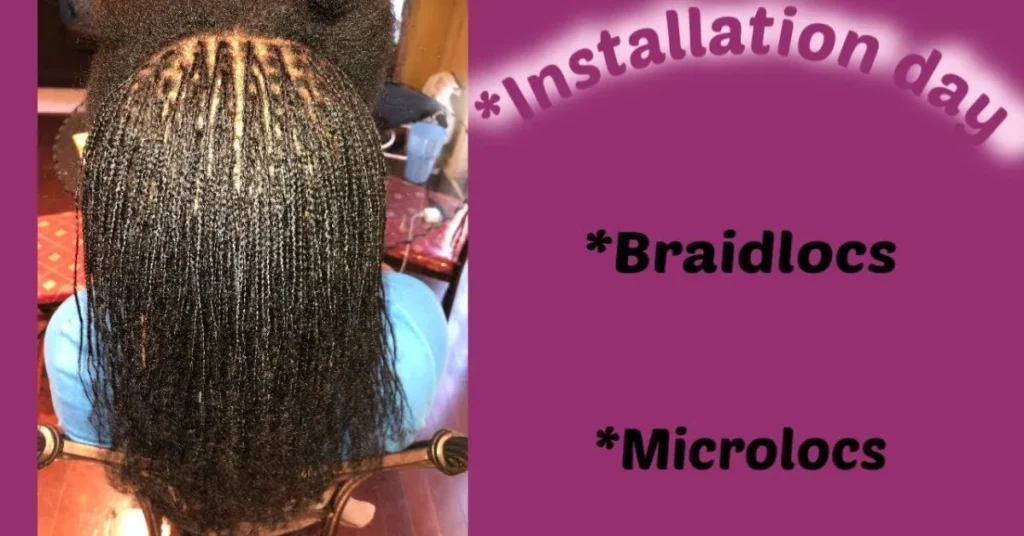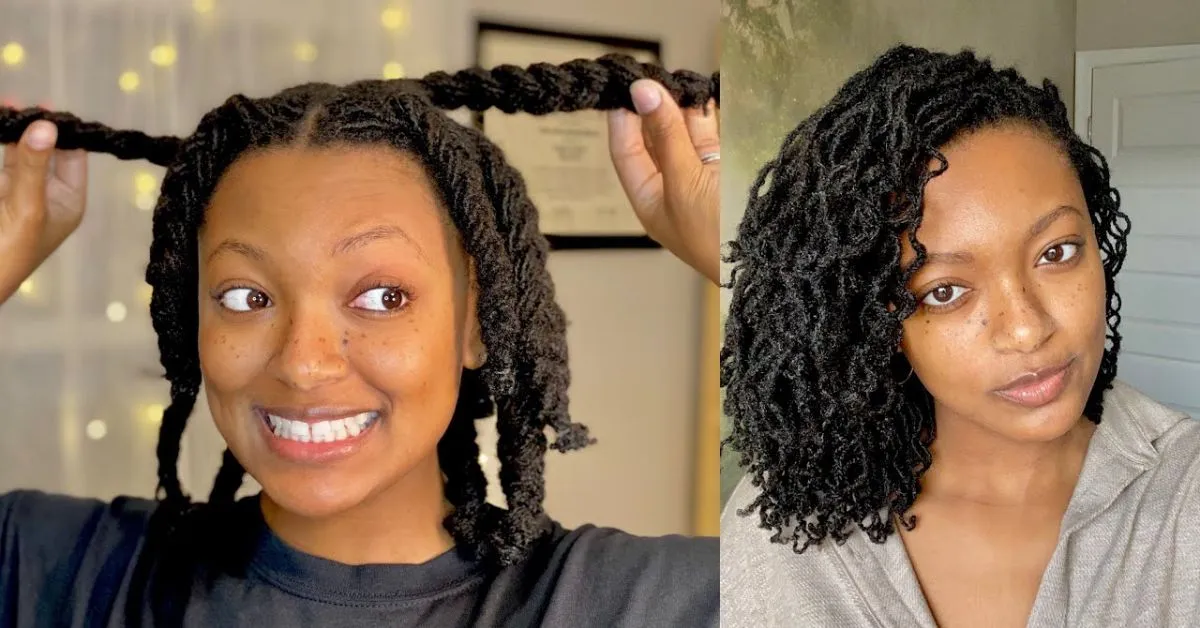When choosing a hairstyle that suits your personality and lifestyle, there are various options available. Among the trending hairstyles for natural hair are micro locs and sisterlocks.
Both are popular choices among individuals looking for a low-maintenance yet stylish look. In this guide, we’ll delve into the intricacies of micro locs and sisterlocks, exploring their differences, advantages, and disadvantages to help you make an informed decision.
What Are Microlocs?

Microlocs are a type of hairstyle that involves creating small, uniform sections of hair and then tightly coiling or twisting each section to form small, cylindrical locks.
These locks are typically created using a palm rolling or interlocking technique, depending on the preference of the individual and their hairstylist.
Pros and Cons of Microlocs
Pros:
Versatility
Microlocs offer versatility in styling options. They can be worn in various ways, including updos, ponytails, or left down for a more natural look.
Low Maintenance
Once established, microlocs require minimal maintenance, making them ideal for individuals with busy lifestyles.
Scalp Health
Microlocs allow for better airflow to the scalp, promoting scalp health and reducing the risk of buildup or scalp issues.
Length Retention
Due to their low manipulation nature, microlocs can aid in retaining length for individuals looking to grow their hair.
Cons:
Installation Time
The process of creating microlocs can be time-consuming, especially for individuals with thick or long hair.
Initial Tightness
Some individuals may experience discomfort or tightness during the initial stages of micro loc installation.
Potential Breakage
Improper installation or maintenance techniques can lead to breakage or damage to the hair.
Limited Styling Options
While microlocs offer versatility, some individuals may find them restrictive compared to other hairstyles.
What Are Sisterlocks?

Sisterlocks are a variation of traditional locs, characterized by their smaller size and intricate pattern. Unlike micro locs, sisterlocks are installed using a specific technique.
It involves creating tiny, uniform sections of hair using a specialized tool called a sister lock tool. These sections are then interlocked to form small, tight locks.
Pros and Cons of Sisterlocks
Pros:
Small Size
Sisterlocks are smaller in size compared to traditional locs, giving them a more refined and elegant appearance.
Lightweight
Due to their small size, sisterlocks are lightweight and less bulky, making them comfortable to wear.
Styling Versatility
Despite their small size, sisterlocks offer versatility in styling options, allowing for various updos, twists, and braids.
Scalp Health
Like microlocs, sisterlocks promote scalp health by allowing for better airflow and reducing buildup.
Cons:
Installation Cost: Sisterlocks require specialized training and tools, which can result in higher installation costs compared to other hairstyles.
Maintenance
While sisterlocks are low maintenance once established, they require regular retightening sessions to maintain their appearance.
Installation Time
The process of installing sisterlocks can be lengthy, especially for individuals with thick or long hair.
Tightness:
Some individuals may experience tightness or discomfort during the initial stages of the sister lock installation.
Microlocs vs Sisterlocks: What’s the Difference?
Now that we’ve explored the basics of micro locs and sisterlocks, let’s delve into the key differences between the two hairstyles.
1. Installation and Maintenance Cost
- Microlocs
The cost of installing microlocs can vary depending on factors such as hair length, thickness, and the salon’s location. On average, installation costs range from £200 to £600.
Maintenance costs are relatively low, typically ranging from £50 to £150 for retightening sessions every 6-8 weeks.
- Sisterlocks:
Due to the specialized training and tools required, sisterlocks tend to be more expensive to install, with costs ranging from £500 to £1500. Additionally, maintenance costs can be higher, averaging £100 to £300 for retightening sessions every 4-6 weeks.
2. Installation Technique
- Microlocs:
Microlocs are typically installed using either a palm rolling or interlocking technique, depending on the preference of the individual and their hairstylist.
- Sisterlocks:
Sisterlocks are installed using a specific technique that involves creating tiny, uniform sections of hair using a specialized tool called a sister lock tool.
3. Installation Time
- Microlocs:
The installation process for microlocs can be time-consuming, especially for individuals with thick or long hair. On average, it can take anywhere from 8 to 20 hours to install microlocs.
- Sisterlocks:
Similarly, the installation process for sisterlocks can be lengthy, with installation times ranging from 20 to 40 hours, depending on factors such as hair length and thickness.
4. Maintenance
- Microlocs
Microlocs require minimal maintenance once established, with retightening sessions needed every 6-8 weeks to maintain their appearance.
- Sisterlocks
Sisterlocks also require regular maintenance, with retightening sessions needed every 4-6 weeks to keep the locks tight and neat.
Frequently Asked Question
What are Micro Locs and Sisterlocks?
Microlocs and Sisterlocks are both methods of creating small, uniform locks in natural hair. They are popular among individuals seeking low-maintenance hairstyles and are often used as alternatives to traditional dreadlocks.
What’s the main difference between Microlocs and Sisterlocks?
The main difference lies in the technique and size. Microlocs are typically larger than Sisterlocks and are created using various methods like braiding, twisting, or palm rolling.
Sisterlocks on the other hand are trademarked and created using a specific grid pattern with a specialised tool. It resulted in much smaller and more uniform locks.
Which one is better for different hair types?
Microlocs are often recommended for thicker hair types or hair with more texture, as they provide more versatility and can be easier to maintain.
Sisterlocks with their smaller size are suitable for finer hair types or those seeking a more tailored, intricate look.
How do maintenance and retightening compare between the two?
Maintenance for Microlocs usually involves palm rolling or twisting the roots to keep them neat. Sisterlocks require more frequent retightening sessions due to their smaller size and precise grid pattern.
It is typically every 4-6 weeks. Microlocs may have longer intervals between retightening sessions, depending on the desired look and hair texture.
Are there differences in styling options?
While both styles offer flexibility in styling, Sisterlocks tend to offer more intricate styling options due to their smaller size and uniformity.
Due to their larger size and texture variation, Microlocs may be more conducive to certain styles like braids or twists. However, both styles can be styled in various ways to suit individual preferences and occasions.
Conclusion: Which Is Better Microlocs or Sisterlocks?
Both micros loc and sisterlocks offer unique benefits and drawbacks, making them suitable for different individuals depending on their preferences, lifestyles, and budgets. The choice between micro locs and sisterlocks comes down to personal preference and what works best for your hair type.
It’s essential to consult with a professional hairstylist experienced in both styles to determine which option is right for you. In the next section we’ll dive deeper into styling options and tips for maintaining micro locs and sister locks. Stay tuned for more valuable insights.
